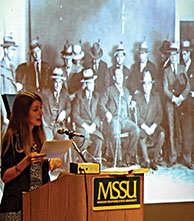Speaker offers the truth behind mafia legend

Terri-Lynn Frasher Terri-Lynn Frasher/The Chart
Dr. Monica Seger introduces “Mafia Culture: History and Representation in Italy and Beyond. The first of her three presentations for the Italian themed semester, on Sept. 9
Dr. Chad Stebbins introduced Dr. Monica Seger, assistant professor of Italian from Oklahoma State University, for the first of three scheduled presentations of the day. The first presentation was titled Mafia Culture: History and Representation in Italy and Beyond.
Seger outlined the history of the culture that contributed to the formation of the organization known as the mafia. She said the organization was both a cause and effect of Sicily’s social problems.
She defined the mafia as a fraternal organization serving as an alternative to official branches of city and state government.
She said there are several other organized criminal groups in other parts of Italy, but focused mainly on Cosa Nostra, the Sicilian-based organization.
The mafia prospered and grew unchecked from the 1700s through the unification of Italy, coexisting rather peacefully alongside the government and even aiding in controlling an increase in bandits and thievery.
In post-World War I Italy, new Prime Minister Benito Mussolini tried to restore order. He began an anti-mafia campaign. The campaign lasted from 1925-1929 and resulted in the opposite effect.
Seger touched briefly on the immigration to North America of Sicilian mafioso and the development and expansion as it grew stronger in the 1930s aided by prohibition and later by a willingness to form a North American coalition of families coming from New York City to Cincinnati and Chicago in the succeeding decades.
The remaining decades of the twentieth century were prosperous for Cosa Nostra as the drug trade expanded and became more organized. It was characterized by increasing violence and infighting among the families.
No official government efforts have proven effective in stopping the organization known as Cosa Nostra, Seger said.
Your donation will support the student journalists of Missouri Southern State University. Your contribution will allow us to purchase equipment and cover our annual website hosting costs.



























